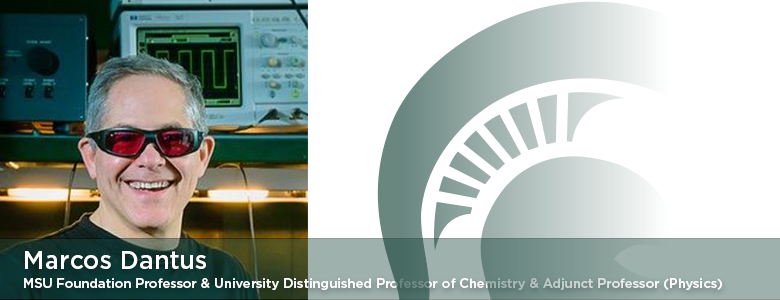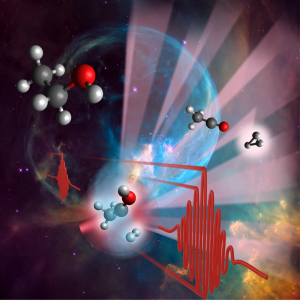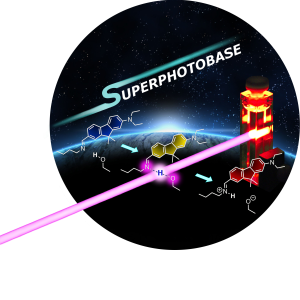Marcos Dantus

Research
Ultrafast Science
(Research Description PDF)
Ultrafast lasers, with pulse durations shorter than 10–13 s, less time than it takes for atoms to move, have already led to three Nobel Prizes in Chemistry and Physics. Our group has two well-funded thrust areas research:

(a) Understanding and controlling chemistry under intense laser field radiation Within the optical period of an intense laser an electron is pulled out from a molecule, it is accelerated, and then is driven back to the molecule as the laser field reverses its direction. The resulting high-energy electron collision results in exotic types of chemical reaction mechanisms, that have either never been observed or very little is known about their dynamics. These reactions are relevant to astrochemistry, chemical reactions occurring under X-ray radiation, and electron impact mass spectrometry. In our lab, we take advantage of laser sources and pulse shaping methods we have developed to understand and control the dynamics of chemistry induced by strong laser fields. Our recent projects include studies of chemical reactions relevant to interstellar chemistry and the formation of H3 +. H3 + is the most important ion in the universe because it is responsible for the formation of most organic molecules in the universe and perhaps responsible for life in the universe. Its formation from organic molecules requires dissociation and formation of multiple chemical bonds in about 10–13 seconds. Our group is focusing on fundamental processes which proceed through the formation of a neutral H2 molecule that roams the precursor until it extracts an additional proton. More recently started exploring the dynamics of retro-Diels-Alder reactions in radical cations. We have found that concerted bond breaking is correlated with coherent vibrational motion in the molecular ion.

(b) Developing tools and compounds for controlling chemistry in space and time The ability to design light pulses that drive a specific chemical reaction enables technological advances in a range of fields from sensing, to energy conversion, to green chemistry. Thus, it is essential that new strategies towards this grand challenge are developed. This project is enhanced by close collaboration between synthesis, theory, and spectroscopy. A specific goal is to understand how to circumvent spontaneous energy flow to achieve chemical reactivity in excited states. For this project we use a wide range of frequency and time-resolved spectroscopies. The capabilities developed here will influence a range of fields that benefit from precise control of quantum objects, e.g. novel strategies for super-resolution microscopy, coherent control of chemical reactions, nanophotolithography, and strategies for creating luminescent centers in transparent materials that can be used for quantum information sciences.
This project implements novel strategies for quantum control of energy flow and reactivity in large organic molecules. Recognizing that different electronic excited states may be highly reactive, shaped laser pulses will be used to (a) populate electronic states with desirable reactivity, and (b) minimize the probability of spontaneous transition out of the desired electronic state. In pursuit of (b), quantum control strategies that range from semi-classical (driving the vibrational wave packet along a particular reaction coordinate) to quantum strategies with no classical analogue will be used. For example, topological effects near intersections between electronic states can be exploited to influence the reaction outcome and strong coupling, where the potential energy surfaces are dressed by the light field, can alter the natural energy flow enhancing coherence with the driving field.
Contact / Webpage
Area(s) of Interest
Physical (Ph)
Analytical (An)
Biological (Bi)
Chemical Physics (CP)
Selected Publications
Spectral phase control of the quantum interference between two-photon optical excitation pathways, J. Lahiri, et al., arXiv:2103.09912 (2021).
Milliradian precision ultrafast pulse control for spectral phase metrology, J. Stamm, J. Benel, E. Escoto, G. Steinmeyer and M. Dantus, Optics Express 2021, 29, 14314-14325.
Chemical complexity of the retina addressed by novel phasor analysis of unstained multimodal microscopy, J. Kline and M. Dantus, Chem. Phys. 2021, 543, 111091.
Isoenergetic Two-Photon Excitation Enhances Solvent-to-Solute Excited-State Proton Transfer, J. Lahiri, et al., J. Chem. Phys. 2020, 153, 224301.
Control of electron recollision and molecular nonsequential double ionization, S. Li, et al., Comm. Phys. 2020, 3, 35.
Proton Abstraction Mediates Interactions between the Super Photobase FR0-SB and Surrounding Alcohol Solvent, J. Lahiri, et al., J. Phys. Chem. B 2019, 123, 8448.
Quantum coherent control of H3+ formation in strong fields, M. J. Michie, et al., J. Chem. Phys. 2019, 150, 044303.
H2 roaming chemistry and the formation of H3+ from organic molecules in strong laser fields, N. Ekanayake, et al., Nat. Commun. 2018, 9, 5186.
CV
B.A. & M.A., 1985, Brandeis Univ.
Ph.D., 1991, California Institute of Technology
Postdoctoral Research Fellow, 1991-93, California Institute of Technology
Member, 2014–, National Academy of Inventors
Awards
| Year | Award | Organization |
|---|---|---|
| 2019 | Technology Transfer Award | Michigan State University |
| 2016 | University Distinguished Professor in Chemistry and Physics | Michigan State University |
| 2016 | MSU Foundation Professor | Michigan State University |
| 2015 | Fellow of the American Physical Society | |
| 2014 | Elected Fellow of the National Academy of Inventors | |
| 2014 | Elected Fellow of the Optical Society of America | |
| 2013 | MSU Innovator of the Year award | |
| 2010 | Science and Technology Awards from Corp! magazine | Biophotonic Solutions |
| 2008 | Distinguished Faculty Award | |
| 2005 | Outstanding Faculty Award | College of Natural Science |
| 2001 | Featured in article | ACS 125th Anniversary Issue of Chemical and Engineering News |
| 1998 | Alfred P. Sloan Fellowship | Alfred P. Sloan Foundation |
| 1998 | Teacher-Scholar Award | Camille and Henry Dreyfus Foundation |
| 1996 | Eli Lilly Teaching Fellowship | Michigan State University |
| 1995 | Packard Fellowship for Science and Engineering | The David and Lucile Packard Foundation |
| 1995 | Beckman Young Investigator Award | Beckman Foundation |
| 1994 | General Electric Foundation Faculty Award | General Electric |
| 1993 | New Faculty Award | Camille and Henry Dreyfus Foundation |
| 1992 | Nobel Laureate Signature award for Graduate Education in Chemistry | American Chemical Society |
| 1991 - 1993 | Postdoctoral Research Fellow | California Institute of Technology |
| 1991 | Ph.D. | California Institute of Technology |
| 1991 | Milton and Francis Clauser Doctoral Prize | California Institute of Technology |
| 1991 | The Herbert Newby McCoy Award | California Institute of Technology |
| 1985 | Bachelor of Arts Magna Cum Laude | Brandeis University, Waltham, MA |
| 1985 | Melvin M. Snider Prize in Chemistry | Brandeis University, Waltham, MA |
| 1985 | Phi Beta Kappa | Phi Beta Kappa (Brandeis University, Waltham, MA) |
| 1985 | Earl C. Anthony Fellowship | California Institute of Technology |
| 1985 | Bachelor of Arts | Brandeis University, Waltham, MA |
| 1985 | M.A. | Brandeis University, Waltham, MA |